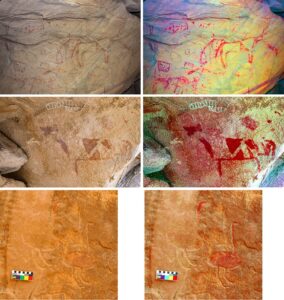A multi-institution study of the use-wear evidence on grinding tools excavated in the Nefud Desert of northern Saudi Arabia suggests a variety of practical uses from processing plants for baking bread and crushing bone to access marrow, offering fresh insights into a little understood chapter of the human story between 8,000 to 6,000 years ago.
The PLOS ONE research, which was co-led by Griffith University’s Professor Michael Petraglia, was based on use-wear analysis on five grinding tools that he and the team excavated at Jebel Oraf, at the UNESCO site of the Jubbah Oasis, in the Nefud Desert of northern Saudi Arabia.
Results show evidence for bone, plant and pigment processing in the Neolithic, and support previous research conducted by Professor Petraglia and the international team on painted rock art and faunal remains.

Professor Michael Petraglia.
Professor Petraglia, who is Director of Griffith’s Australian Research Centre for Human Evolution, said the use-wear analysis of the grinding tools from the Jebel Oraf site in the Nefud desert showed the artifacts were used during the Neolithic, shedding new light on the subsistence and lifestyle of ancient peoples in the region.
“In recent years, studies have revealed that the now-arid region of northern Arabia was once much wetter and greener, providing Neolithic human populations with access to both water and game,” Professor Petraglia said.
“The present aridity of the region, however, preserves little organic matter, making a reconstruction of the Neolithic lifestyle difficult.”
Use-wear analysis shows that grinding tools were used for the processing of bone, pigment and plants, and were sometimes re-used for different purposes during their life span, before finally being broken up and placed on hearths.
In the new study, researchers use high-powered microscopes to compare use-wear patterns on the archaeological tools with those on experimental tools.
In experiments, the grinding of grains, other plants, bone or pigment produces distinctive macro- and micro-traces on the tools’ used surface, including fractures, edge rounding of individual grains, levelled areas, striations, and different types of polish. These distinctive traces were also identified on the Neolithic grinding tools, allowing the scientists to determine which materials were being processed.
Although faunal remains have previously revealed that meat was cooked and consumed at Jebel Oraf, wear patterns indicate that meat and bones were first processed on grindstones, revealing the possibility that bones were broken to access bone marrow.
Grinding tools were also used to process plants. While there is no evidence for domesticated grains in northern Arabia in this period, the authors argue that wild plants were ground and perhaps baked into simple breads.
“The hearths where we found the grinding tools were extremely short-lived, and people may have been very mobile – breads would have made a good and easily transportable food for them,” says Maria Guagnin, researcher at the Max Planck Institute of Geoanthropology and one of the study’s lead authors.

Painted rock art from northern Saudi Arabia hints at the importance of pigment processing. Photo credit: Maria Guagnin
The researchers also found evidence of pigment processing, which they argue may be linked to Neolithic rock art paintings.
Their findings reveal pigment was ground and processed on a larger scale than previously assumed, suggesting there may have been more painted Neolithic rock art than the few surviving panels suggest.
This type of analysis has only rarely been applied to archaeological materials from the Arabian peninsula, but can provide important information on the manufacture, use, and re-use of grinding tools, which in turn provides insight into the subsistence, economy, and art of the people who produced them.
“It is clear grinding tools were important for the Neolithic occupants of Jebel Oraf,” said Giulio Lucarini of the National Research Council of Italy, the study’s other lead author.
“Many were heavily used, and some even had holes in them that suggest they were transported. That means people carried heavy grinding tools with them and their functionality must have been an important element in daily life.”
Researchers involved in this study work in close partnership with the Heritage Commission, Saudi Ministry of Culture. Additional partners include King Saud University and key institutions, the Max Planck Institute of Geoanthropology, the National Research Council of Italy, Institute of Heritage Science (CNR ISPC), University College London and University College Ireland.
The study ‘Plant, pigment, and bone processing in the Neolithic of northern Arabia – New evidence from use-wear analysis of grinding tools at Jebel Oraf’ has been published in PLOS ONE.
